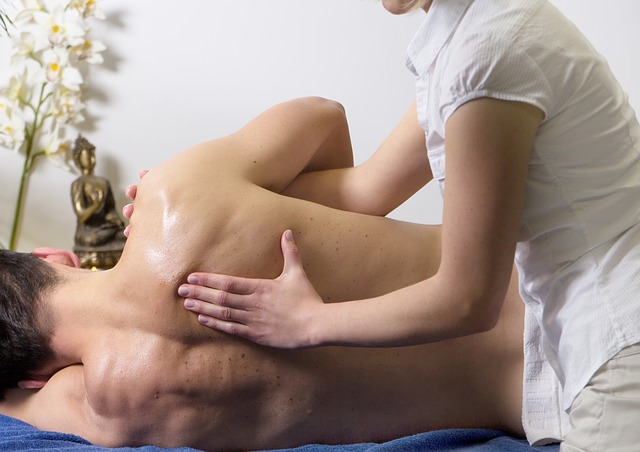Our shoulders are the most mobile joints in our bodies. They are, in a word, amazing. However, because of their impressive range of motion and the “weight of the world” we place on them, the shoulder joint is the most unstable, and this often leads to a variety of chronic and acute injuries. Two common complications are bursitis, and frozen shoulder.
What is Bursitis?
Bursitis is inflammation of the bursa. Bursae are synovial fluid sacs, the pouches of lubrication found in joints to help muscles slide over each other smoothly. If the Tin Man from the Wizard of Oz had bursae, he wouldn’t have needed his oil can. This is essentially what bursae do for us, they keep our joints well-oiled and moving. Along with other joints like hips and knees, bursitis is common in the shoulders.

Bursitis is usually caused by an injury, either acute or chronic. An acute injury is sudden trauma, such as a sporting incident, a fall, or a car accident. A chronic injury is one that happens from repetitive strain. Either way, bursitis usually takes a while to develop, and it can take just as long to heal.
Bursitis gives a localised pain, but it’s typical that the surrounding soft tissues are involved, and can sometimes refer pain to other areas, which can make it confusing to diagnose. Bursitis is rarely a stand-alone issue, and this is where massage comes in.
Massaging the soft tissue surrounding a joint with bursitis is one of the keys to recovery. Whether the bursitis was caused by sudden trauma or slow repetition, the muscles and ligaments that work the joint may be restricted by scar tissue, tight fascia, or trigger points. This restriction increases the pain, decreases the range of motion, and slows down healing.
Bursitis is inflammation, so in order to heal, the bursa needs to stop being inflamed. There are a few things to consider here as steps:
Stop the irritating action! Whatever action makes it hurt, cut it out if you can – it’s time to rest.
If it’s sore and throbbing, get some ice on it to reduce the inflammation. Don’t overdo the ice, but 20mins of icing the bursitis site every few hours can be helpful.
Anti-inflammatories. This can come in pill form for immediate pain-relief, but it really should be done more by diet for the long-term. There are certain inflammatory foods that should be avoided: Sugar, Gluten, Trans fats, Nightshades. You might not have to give them up forever, but while you’re battling inflammation in your body, it’s just pushing a boulder uphill if you’re CAUSING further inflammatory responses from your system. There are also several foods that REDUCE inflammation: Pineapple, turmeric, ginger, berries, and good fats (nuts, coconut oil, fish). Our diet can either be our hurt or our healing.
Cortisone Injection. Doctors will usually recommend cortisone if the bursitis is bothering you. Cortisone is closely related to cortisol – a hormone that is naturally produced by the adrenal glands. Cortisol is vital for many bodily functions, including controlling inflammation. Cortisone can be injected into the bursitis to dramatically reduce inflammation. NOTE: There is risk involved every time you put something unnatural into your body. Cortisol is natural, but cortisone is synthetic, and there are several risks and possible side-effects, especially to diabetics. It's also a painful and expensive procedure, so it's not something to rush into.

Frozen Shoulder
Frozen shoulder, or adhesive capsulitis, is characterized by pain and limited movement of the shoulder joint. This condition has three stages:
1. Freezing
This stage is painful, and as the pain increases, the sufferer uses the shoulder less and less. This lack of movement causes the tissues to become dehydrated, and the fibres become sticky.
2. Frozen
This doesn’t mean that the shoulder doesn’t move at all, but there will be definite restriction, and usually the arm can’t be raised above the head. The pain doesn’t get worse from here, in fact, it usually lessens. The shoulder is just stuck, and it hurts to try to push it past its new limits.
3. Thawing
Movement slowly returns, and the pain will come and go. This stage can take anywhere from months to years.
How do you get a frozen shoulder?
It’s often a result of an untreated injury, or post-surgery, because the sufferer uses the shoulder less and less due to discomfort. Bursitis can sometimes lead to frozen shoulder, because you’re trying to rest the overused inflamed shoulder, but it freezes from underuse. It’s important to seek professional advice for shoulder injuries, and make sure that you have proper exercises and monitoring to prevent further damage.
Frozen Shoulder is actually not fully understood yet, but research shows that those who are more likely to develop it are women between 40-60 years of age, diabetics, people with thyroid problems, and those with Addison’s or Parkinson’s Disease.

Can Massage help frozen shoulder?
YES. The problem is that there is limited range of movement, insufficient blood flow to the shoulder, and varying levels of pain in surrounding muscles. Go to your massage therapist! Blood flow is our business, and skilled remedial massage therapists can use myofascial release and muscle energy techniques to increase movement and manage pain.
If you suffer from undiagnosed shoulder pain, seek professional help. You can start with remedial massage to see if it’s a simple soft tissue adhesion, or go to the GP for a scan. The important thing is to manage the pain, get free movement in all directions, and keep the shoulder functioning. Because if you get into the habit of guarding it instead of using it, you run the risk of it freezing. Move it or lose it.





